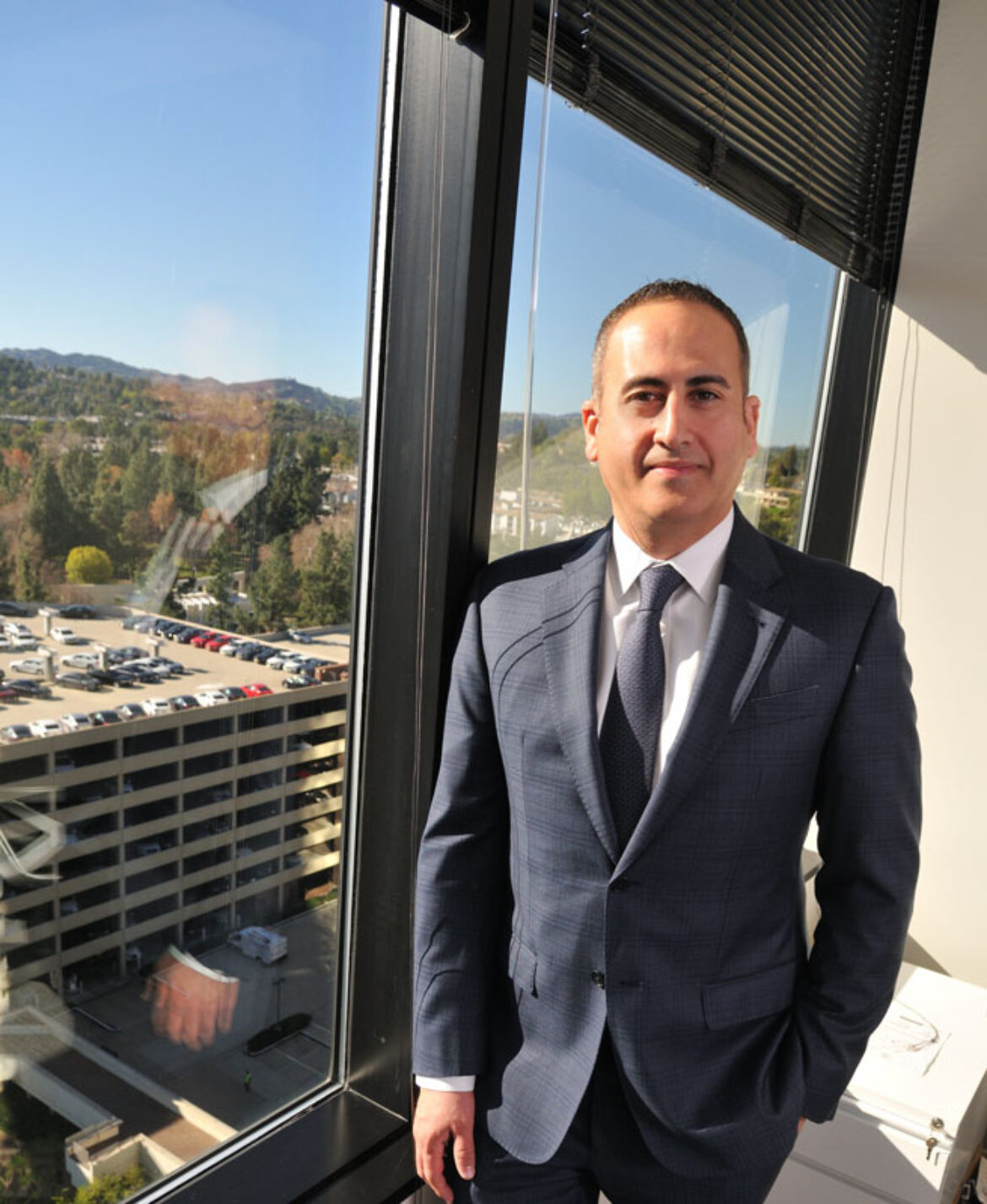
Photographer: Thomas Wasper at The San Fernando Valley Business Journal
Tech Savvy: Yair Haimoff started virtual walk-throughs before the pandemic.
By MICHAEL AUSHENKER Staff Reporter
Until recently, virtual tours of commercial and residential real estate proper-ties were something of a novelty and virtual leasing a rare option. 1ow, during pandemic times, they have become a necessity.Local property owners and brokers, who have already flirted and familiarized them-selves with virtual tours for the past few years, are relying heavily on the technology to get them through the social distancing requirements during the shutdown period as the coronavirus situation prevents prospective investors and renters from visiting properties in person because of liability reasons.
Chicago-based real estate investment firm Waterton Property Management has aggressively employed virtual tours and leasing in the marketing of its new apartments at Chase knolls in Sherman Oaks.
Located at 13401 Riverside Drive and occupying a large block, Chase Knolls is not your average Valley mid-century apartment complex. Waterton is beginning to wrap up its first phase on an overhaul project that was long resisted by locals. Designed by pioneer African-American Modernist architect Ralph Vaughn and built in 1949, the garden apartments took the place of a dairy farm as a reflection of the Valley’s post-WWII boom. In 2000, four years before Waterton acquired Chase Knolls and announced plans to enhance it with an expansion project, the apartments were declared a Los Angeles landmark. With parklike paths and shady courtyards, the Los Angeles Conservancy considered this address a prime example of the ideal postwar utopian village.
With those issues in the rearview, Water-ton originally readied to roll out its upgrade in stages starting in May and through mid- to late-2021, Waterton has been renovating 260 of what it calls its “classic units” while building 141 new residences to the historic project.
“We’re really trying to keep the mid-century style,” Tina Miserendino, director of marketing and branding for Waterton, told the Business Journal.
“We had a lot of (virtual) technology in place prior to the virus,” Miserendino said, explaining that they got on board three years ago “when that concept rolled out in an incubator. We rolled it out at a portion of our properties, and we saw a great success.”
Utilizing Realync a real-time virtual live-tour software ± a potential buyer can walk through a Chase .nolls apartment with the leasing agent, who is physically walking through the home and delivering video and narration via a tablet or cellphone.
“Each of our associates are creating video that they can email,” Miserendino said.
Before the pandemic, occasional buyers in a different state or city might take the virtual route and buy a property without as much as an in-person visit.
We call those (types of buyers) ‘site unseen’ leasing,” Miserendino explained. “If you love the specific unit, the leasing agent would lead you to our property website. There’s an area you can apply. Hit the apply link, fill out information, go through our normal screening process.”
Typically, after 24 to 48 hours, when the buyer gets an approval and a move-in date, a commitment is a commitment. But during the pandemic, potential renters can get a full refund 72 hours prior to moving in, in a policy Waterton is presently offering through the end of July.
If you’re dissatisfied, within 30 days from the move-in date, you can cancel your lease and move out without penalty and only pay the days you’ve been living with us,” Miserendino said. “The move out must be within the 30 days from the move in date.”
Virtual growing reality
Waterton is currently conducting internal discussions regarding self-guided tours, but it’s not as easy as having a potential buyer sign a waiver, the company representative explained.
“We would have to really think about the liabilities and legality of not being present when they are going through the property,” Miserendino said. “(But) that’s definitely in our pipeline. We’ve actually explored (this idea) prior to the coronavirus.”
Meanwhile, she continued, virtual leasing will be the standard during the virus crisis.
“The fact that we live in our digital age is actually going to help us achieve our leasing goals,” Miserendino said. “’With the current circumstance, this is an amazing option.”
Not every property owner has embraced virtual leasing during the crisis, noted Janette, senior director of National Multi Housing Group at Marcus & Millichap’s Encino office. She explained that it depends on whether the building owners are huge firms or smaller, independent investors.
“As far as I am aware, there is a real lull for owners in renting out their vacant units,” Monfared said. “A lot of small mom-and-pop (multifamily property owners) do not have the tools for this. I think owners of larger and newer properties, large companies, are the ones really taking advantage of the virtual property tour.”
However, companies not employing such technology may soon become the outlier, said Yair Haimoff, chief executive of Spectrum Commercial Real Estate Services in Encino, who noted that his agency started doing virtual tours long before the catastrophe hit.
“We actually began utilizing the features as most prospects were too busy to tour spaces during normal business hours and the fastest way was to set up virtual tours so the prospects could walk through the space virtually,” said Haimoff. “We also have detailed 3-D floorplans for each space that we lease.”
Spectrum’s brokers still conduct personal tours. However, “we pre-screen each prospect and make sure that everyone (brokers and clients) wears a mask to the showing,” Haimoff said.
Sales cycles
Karen Schakarov, vice president of marketing for Peak Corporation Network in Woodland Hills, said that, right now, showing places in person is no longer an option. The Peak Century 21 branch is run by Eli Tene and Gil Priel.
“Eli was ahead of the curve (with tech),” Schakarov said. “We own our own meta-port, a 3-D virtual camera. You can post it, you can promote it. Additionally, we try and do a Facetime with the leasing agent. … Today, that’s the only way to show a property.”
Peak can close deals on single-family homes, multifamily properties, and commercial properties, such as strip malls, via virtual leasing. However, it might be too early in the run of the coronavirus crisis to see deals closed from beginning to end virtually. While the volume of sales has slowed significantly since March, sales currently in play are tied up with virtual, as owners had visited the sites prior to the outbreak.
“The sales cycle is too long for that,” she said of seeing deals beginning and ending during the crisis.
Schakarov also mentioned that Tene and Priel are picking up the tab on technology expenses to support their sellers.
“Usually, an agent pays for everything,” she explained. “They pay 100 percent for the photography, the tech, drones,” she explained.
Ultimately, Schakarov continued, despite the abrupt slowdown in real estate, “people still need to buy and sell properties. The need hasn’t changed. The way you execute has changed.”
Schakarov said young adults — millennials and younger — were already embracing online buying before the pandemic broke out. She predicted that the virtual purchase will become an industry norm after the crisis subsides.
“It will be the revolutionary way of buying property this way sooner rather than later,” she said.
Waterton’s Miserendino also believes that virtual tours will stick around past the pandemic and “site unseen” buyers will multiply.
“With the transient nature of the renter in our country, people move state-to-state all the time,” she said. “This technology will continue to be used after the virus. This is just the beginning.”

